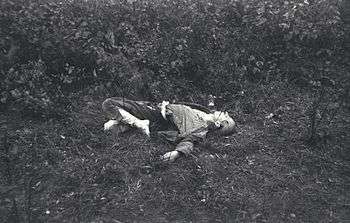Celle massacre
The Celle massacre (euphemistically called "Celler Hasenjagd", "hare chase of Celle") was a massacre of concentration camp inmates that took place in Celle, Prussian Hanover, in the last weeks of the Second World War. Those internees of the concentration camp Salzgitter Drütte who escaped from the forced transport were pursued and beaten or shot by SS guards, Gestapo, and Nazi party officials, as well as members of the public.
Events

On 8 April 1945, a month before the unconditional surrender of Germany, transports from several concentration camps were hit in an airstrike. 2,862 Ukrainian, Russian, Polish, Dutch and French nationals from the Drütte camp, a subcamp to the Neuengamme concentration camp, were forced into freight cars located at the Celle yard en route to the Bergen-Belsen concentration camp.[1] This transport had joined others the day before, making the total count around 4,000 men and women. On this transport, many internees died of exhaustion and malnutrition.[2] The freight train carrying the internees stopped next to an ammunition train, which exploded during the air raid. In the ensuing inferno, most of the wagons carrying the internees were destroyed and a number of them lost their lives.[3] The surviving internees fled either into the town or westward towards the Neustadt wood with the SS troops opening fire on them. As soon as the air raid was over, the SS guards, members of the local Nazi party, Gestapo, the fire-brigade and the public pursued the fleeing internees.[1][2][3]
The internees who were caught and survived were detained on the sports ground off the Neustadt wood. Some 30 persons were executed on suspicion of looting. Most of the surviving internees were marched to Bergen-Belsen, while others were detained at the army's Heide barracks. Only 487 survivors reached Bergen-Belsen on the morning of 10 April — five days before the camp’s liberation by British and Canadian forces; the remainder either died of exhaustion or were murdered on the death marches.[1][2][3]
Aftermath


The British Army liberated Celle on 12 April and launched an investigation into the events of 8 April – 11 April. Their chronicler characterized the Heidekaserne as a "microcosm of Bergen-Belsen". Estimates place the number of "hare hunt" victims at 200–300; the remaining transport prisoners died of other causes.[1]
Only 14 military and police personnel and political leaders were tried in the Celle Massacre Trial, which began in December 1947. Seven were acquitted of murder or accessory to murder because of insufficient evidence, whereas four were found guilty as perpetrators and sentenced to between four and ten years in prison. In addition, three were sentenced to death. One of the death sentences was overturned on appeal and the other two were reduced to 15–20 years' imprisonment as part of a clemency issued by the British military governor. All those imprisoned were released by October 1952 for good behaviour.[1][2]
See also
Further reading
- Freeman, Roger A; Crouchman, Alan; Maslen, Vic; (1990), The mighty Eighth war diary, Rev. ed, London: Arms and Armour Press, OCLC 59830319
- Saft, Ulrich, (1990), Krieg in der Heimat - das bittere Ende zwischen Weser und Elbe, Langenhagen: U. Saft, ISBN 3-9801789-0-0 (German)
Sources and references
- 1 2 3 4 5 Bertram, Mijndert (1989), April 1945 : der Luftangriff auf Celle und das Schicksal der KZ-Häftlinge aus Drütte (in German), Celle: City of Celle, ISBN 3-925902-09-0
- 1 2 3 4 (German) Höper, Dietrich. “8 April 1945 - Bomben auf Celle” in Celler Zündel, a monthly municipal magazine, pp. p. 15-16, issue of April 1985. Available online at http://www.celle-im-nationalsozialismus.de/Texte/Hoeper_Bomben.html.
- 1 2 3 (German) Buntes Haus e. V. “Die Celler ‘Hasenjagd’ ” in Flugblatt zum 60. Jahrestag des Massakers an KZ-Häftlingen distributed in Celle on 8 April 2005, the date of the 60th anniversary of the event; available online at http://www.celle-im-nationalsozialismus.de/Texte/buha_2005.html.